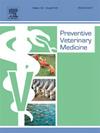Artificial intelligence-enhanced walk-over-weighing system for real-time livestock weight monitoring: A novel approach for precision farming
IF 2.4
2区 农林科学
Q1 VETERINARY SCIENCES
引用次数: 0
Abstract
Accurate and consistent livestock weight monitoring is a cornerstone of modern precision farming, yet conventional methods remain labor-intensive, induce animal stress, and provide infrequent data. While automated systems have emerged, they often lack the intelligence to translate weight data into actionable health insights. This study introduces and validates a novel Artificial Intelligence (AI)-enhanced Walk-Over-Weighing (WoW) system designed to overcome these limitations through real-time, autonomous monitoring.
The system integrates a stress-free platform with high-precision load cells, RFID for individual animal identification, and dual ESP32 modules for robust data processing. Its core innovation lies in a dual AI framework: a Random Forest regression model was developed for precise weight prediction under dynamic conditions, while a One-Class Support Vector Machine (SVM) was implemented for unsupervised anomaly detection. The integrated system was validated on a herd of 90 dairy cows (Holstein and Simmental), with its performance evaluated against static reference measurements.
The results demonstrated exceptional performance. The weight prediction model achieved a coefficient of determination (R²) greater than 0.98 and a Mean Absolute Percentage Error (MAPE) below 0.5 %, signifying high accuracy and reliability even with animal movement. Furthermore, the anomaly detection model proved effective at identifying simulated health events, achieving a classification accuracy of 0.95.
Crucially, these findings establish that the WoW system transcends simple measurement, functioning as a proactive, non-invasive health monitoring tool. By identifying subtle deviations from expected growth patterns, the platform enables the early detection of potential health issues, thereby enhancing animal welfare, reducing economic losses, and promoting more sustainable, data-driven farming practices.
用于牲畜体重实时监测的人工智能增强步行称重系统:一种精准农业的新方法。
准确和一致的牲畜体重监测是现代精准农业的基石,但传统方法仍然是劳动密集型的,会引起动物压力,并且提供的数据不频繁。虽然自动化系统已经出现,但它们往往缺乏将体重数据转化为可操作的健康见解的智能。本研究介绍并验证了一种新型的人工智能(AI)增强行走称重(WoW)系统,该系统旨在通过实时、自主监测来克服这些限制。该系统集成了一个无压力平台,带有高精度称重传感器,用于个体动物识别的RFID,以及用于稳健数据处理的双ESP32模块。其核心创新在于双AI框架:开发了随机森林回归模型,用于动态条件下的精确权值预测,实现了一类支持向量机(One-Class Support Vector Machine, SVM),用于无监督异常检测。该综合系统在90头奶牛(荷斯坦和西门塔尔)上进行了验证,并根据静态参考测量对其性能进行了评估。结果显示了卓越的性能。体重预测模型的决定系数(R²)大于0.98,平均绝对百分比误差(MAPE)小于0.5 %,即使在动物运动的情况下也具有较高的准确性和可靠性。此外,异常检测模型在识别模拟健康事件方面被证明是有效的,达到了0.95的分类精度。至关重要的是,这些发现表明,WoW系统超越了简单的测量,可以作为一种主动的、非侵入性的健康监测工具。通过识别与预期增长模式的细微偏差,该平台能够及早发现潜在的健康问题,从而提高动物福利,减少经济损失,并促进更可持续的、数据驱动的农业做法。
本文章由计算机程序翻译,如有差异,请以英文原文为准。
求助全文
约1分钟内获得全文
求助全文
来源期刊

Preventive veterinary medicine
农林科学-兽医学
CiteScore
5.60
自引率
7.70%
发文量
184
审稿时长
3 months
期刊介绍:
Preventive Veterinary Medicine is one of the leading international resources for scientific reports on animal health programs and preventive veterinary medicine. The journal follows the guidelines for standardizing and strengthening the reporting of biomedical research which are available from the CONSORT, MOOSE, PRISMA, REFLECT, STARD, and STROBE statements. The journal focuses on:
Epidemiology of health events relevant to domestic and wild animals;
Economic impacts of epidemic and endemic animal and zoonotic diseases;
Latest methods and approaches in veterinary epidemiology;
Disease and infection control or eradication measures;
The "One Health" concept and the relationships between veterinary medicine, human health, animal-production systems, and the environment;
Development of new techniques in surveillance systems and diagnosis;
Evaluation and control of diseases in animal populations.
 求助内容:
求助内容: 应助结果提醒方式:
应助结果提醒方式:


